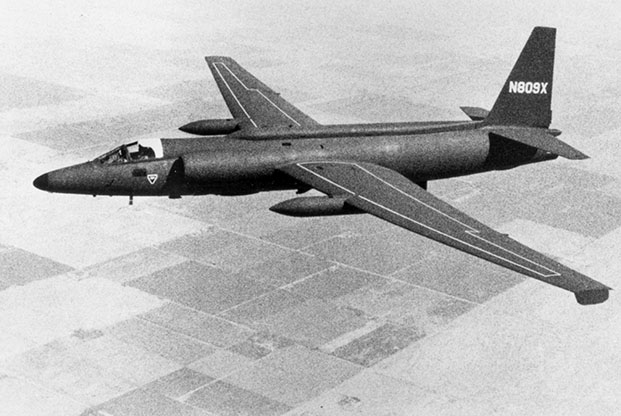 When a U-2C crashed on a spy mission over the Soviet Union in 1960, the United States tried to cover up the incident. Pilot Frances Gary Powers was not at fault—but it took decades for some in the public to accept that. Photo: USAF
When a U-2C crashed on a spy mission over the Soviet Union in 1960, the United States tried to cover up the incident. Pilot Frances Gary Powers was not at fault—but it took decades for some in the public to accept that. Photo: USAF
The mysterious U-2 on the corner of the airfield at Peshawar, Pakistan, the morning of May 1, 1960, had no markings or insignia. It had been flown in the night before by a ferry pilot and would remain on the ground for only a few hours. Takeoff would be soon after daybreak to reduce the chance it would be seen by curious local observers.
In the cockpit was Francis Gary Powers, the most experienced of the Central Intelligence Agency’s U-2 pilots, awaiting the specific order to launch. It came at 6:26 a.m. local time from the White House in Washington, D.C.
The CIA’s U-2s had previously penetrated Soviet airspace 25 times, but this time was different. Each of the previous operations had been a partial overflight, going in for a limited distance, then returning by the same route.
The May Day mission was to be the first complete transit of the Soviet Union, a nine-hour flight of some 3,800 miles from Pakistan to Bodo on the northern coast of Norway.
Powers took off and headed northwest, across the Hindu Kush mountain range. Approaching the Soviet border, he reached penetration altitude of 66,000 feet. He used a single click of his radio switch to indicate no problem that would preclude flying the mission as planned. After that, he was on strict radio silence.
By late afternoon, he had not arrived in Norway. US officials had no clue as to what had happened, but realized that Powers must have gone down somewhere in the Soviet Union. Confimation came May 5 when Soviet leader Nikita Khrushchev announced that the USSR had shot down a US spy plane.
The United States, mistakenly believing that neither the U-2 nor the pilot could survive the fall from the altitudes at which it was flying, responded with a clumsy cover story about a weather plane that had wandered off course.The cover story was demolished on May 7: “We have parts of the plane,” Khrushchev revealed. “We also have the pilot.”
Spin merchants in Washington continued their efforts for several more days, making the situation worse with each new fabrication. President Dwight D. Eisenhower finally put an end to it May 11, acknowledging the intelligence-gathering overflight and taking responsibility for it. Pressed by Khrushchev, Eisenhower said on May 16 that the overflights had been suspended and would not be resumed.
After a show trial in Moscow, Powers was sentenced to three years in prison to be followed by seven years at hard labor. However, in February 1962, he was exchanged in Berlin for Soviet spy Rudolf Abel, who had been held by the United States.
Inquiries by the CIA and Congress not only cleared Powers of any blame for his actions during the flight or in captivity but also commended him. However, the CIA—keeping the veil of secrecy in place—gave him little public support and was displeased when he published his own account in 1970.
The official CIA history was not declassified and released until 1998. Large sections were blacked out, but the document confirmed much of what Powers had said. Even so, some aspects and details of the overflight mission are still undisclosed or in dispute almost 60 years later.
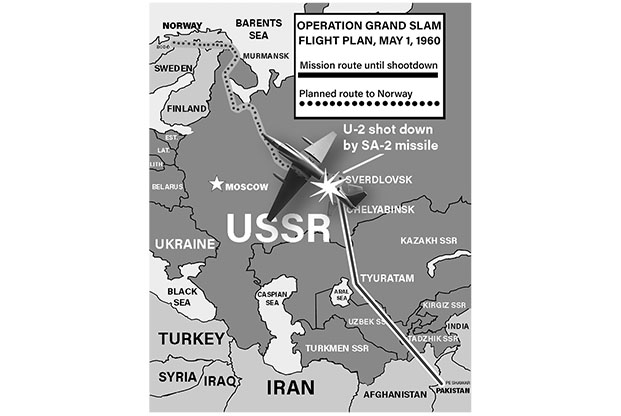
Map: Staff graphic
THE SPECIAL AIRPLANE
Reconnaissance flights by US aircraft along the Soviet border—and sometimes just over it—dated back to the early days of the Cold War. The need was urgent for information about Russian force deployments, the emerging atomic weapons program, and the development of long-range aircraft and missiles.
The shallow penetrations on the periphery provided some data, mostly tactical. US intelligence on matters deep in the Russian heartland consisted of what could be gleaned from World War II German maps and other insubstantial sources.
In an attempt to reduce tensions and uncertainty, Eisenhower’s “Open Skies” proposal in July 1955 suggested that both sides give each other maps of their military installations and provide facilities from which they could conduct aerial surveillance to the extent they desired.
The Russians refused, and shortly thereafter, Eisenhower approved reconnaissance missions in Soviet airspace by the still-secret U-2, which had made its first flight in August 1955.
The U-2 was a radical departure in aeronautical design, developed by Kelly Johnson and the Lockheed “Skunk Works” in Burbank, Calif. It was “basically a powered glider, a jet engine inside a glider frame,” Powers said. The wingspan was 80 feet, almost twice the length of the aircraft, which was not quite 50 feet. It flew at 72,500 feet, more than 13 miles high.
The U-2’s high altitude flight and long range were made possible by major reduction in weight, achieved mainly through a tradeoff of structural strength.
The tail assembly was attached with only three bolts. The main wing spar, which in conventional design passes through the fuselage, had two separate panels, fixed to the side with tension bolts.
“Each piece of structure was a little thinner than a pilot would have liked,” Powers said. “While there was usually extra support, such as joints and junctures, in the U-2 there was none. It was not a plane for heavy or drastic maneuvers.”
Almost half of the U-2’s fuel supply was in tanks inside the “wet wings,” which were narrow and thin. At the end of each wing was a “pogo,” an outrigger with a wheel on it, to keep the wingtip from dragging. Each would be jettisoned on takeoff.
“At maximum altitude, the fastest the plane would go was very close to the slowest it would go,” Powers said. Only six knots separated a low-speed stall from high-speed buffeting, which could cause the loss of wings or tail.
The U-2 mostly avoided public notice, although Model Airplane News had a short article and some drawings in March 1958, and the 1959 edition of Jane’s All the World’s Aircraft had an entry describing the U-2 as a weather research platform.
The CIA was placed in control by Eisenhower, who said, “I want this whole thing to be a civilian operation. If uniformed personnel of the armed services of the United States fly over Russia, it is an act of war—legally—and I don’t want any part of it.” Despite that, the Air Force had a significant presence in supporting roles.
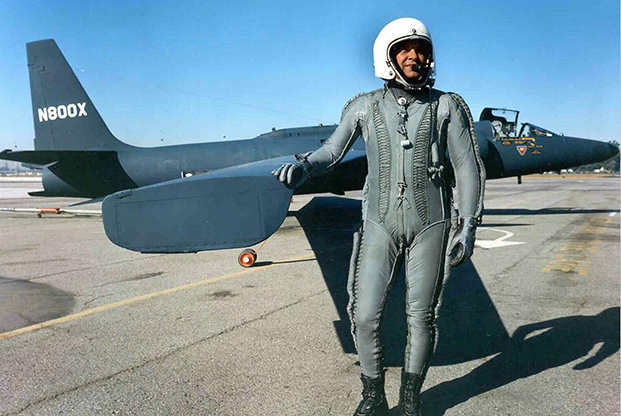
Powers in a CIA photo. Photo: CIA
SHEEP-DIPPED
The pilots were former Air Force officers who entered the U-2 program by a process known as “sheep-dipping.” They resigned from Active Duty to become contract employees of the CIA, but with a secret guarantee that they could return to the Air Force later with no loss in grade or longevity.
Among the first to be recruited was 1st Lt. Francis Gary Powers, an F-84F jet fighter pilot at Turner AFB, Ga., who joined the CIA in May 1956. He and a dozen others underwent training in the U-2 at a remote base in the Nevada desert.
They went overseas in two groups, one to Wiesbaden in West Germany and the other to Incirlik Air Base at Adana in southern Turkey. The first five flights into Soviet territory were out of Wiesbaden in July 1956. The sixth was in November from Adana, with Powers as the pilot.
Gradually, Adana became the mainstay of the program. The CIA called the organization there Detachment 2. To the Air Force, it was Detachment 10-10.
The Air Force provided logistics, and the CIA conducted planning and operations. “There was a commanding officer [USAF] and an executive officer [agency] who together ran the outfit,” Powers said.
The Adana U-2s occasionally flew their missions out of Pakistan, which was closer to the Soviet Union. In such instances, the pilots and ground crew were transported to Peshawar a day ahead of time, and the aircraft was ferried in under the cover of darkness. Should takeoff be delayed, the U-2 would return to Adana before dawn for security reasons.
By 1958, half of the CIA’s hard intelligence on Russia was coming from the U-2.
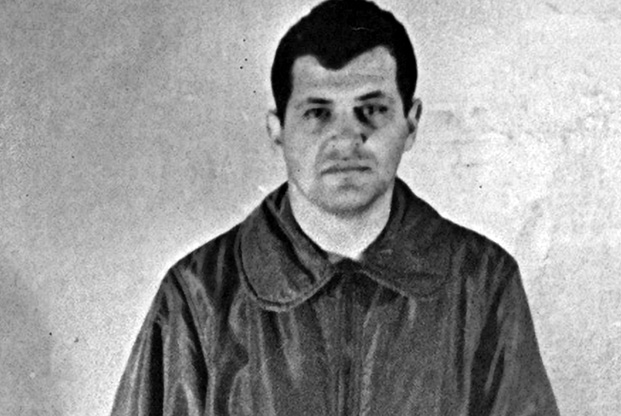
Powers in a Russian prison propaganda shot, was held by the Soviets until February 1962, when he was exchanged for Russian spy Rudolph Abel on the “Bridge of Spies” in Berlin. Photo: RIA Novosti
THE OPERATORS GROW CARELESS
The fundamental assumption was that the high-flying U-2s were beyond the range of Soviet air defenses. There was little guidance to the pilots about what to do if they went down in enemy territory. An intelligence officer told Powers, “You may as well tell them everything, because they’re going to get it out of you anyway.”
A further assumption was not shared with the pilots. “I had been assured that if a plane were to go down it would be destroyed either in the air or on impact, so that proof of espionage would be lacking,” Eisenhower said. “Self-destroying mechanisms were built in.” The CIA told Eisenhower that no pilot would survive to be captured.
In later years, great controversy would arise about the destruction devices Powers supposedly could have used to destroy his airplane and the means he had to kill himself rather than falling into Soviet hands.
According to Powers, the destruct mechanism was a two-and-a-half-pound charge to destroy the camera and other equipment in the bays behind the wings. It was not sufficient to blow up the airplane, nor was it intended to do so. This was confirmed by the CIA’s statement after Powers’ interrogation in 1962.
Suicide measures were offered to the pilots, to be used at their discretion if faced with imminent torture. “There were no instructions that he should commit suicide and no expectation that he would do so,” Powers said.
The first such device was a cyanide pill. Powers never carried it, nor did most of the other pilots. It was replaced with what appeared to be a regular silver dollar with a key chain loop at the end. Inside the loop was a thin needle coated with a deadly poison, curare. Offered the silver dollar before the May Day flight, Powers decided to take it. The intelligence officer pointed out that it could also be used as a weapon.
In retrospect, the CIA’s official history concluded, “after almost four years of successful U-2” missions, CIA leaders “had become overconfident and were not prepared for the ‘worst-case’ scenario that actually occurred in May 1960.”
In March 1960, the USAF Air Technical Center warned the CIA that the Soviet S-75 Dvina surface-to-air missile had “a high probability of successful intercept at 70,000 feet.” This was the same missile that—known by its NATO designation of SA-2 Guideline—took a heavy toll on US aircraft in Vietnam.
As Powers acknowledged in his memoir, he had become complacent, too. In packing for the May Day mission, he thought mainly of what he might need on the short layover in Norway. In addition to civilian clothes and his shaving kit, he took along a Defense Department ID card authorizing medical care and PX privileges, an instrument rating card, and US and international driving licenses.
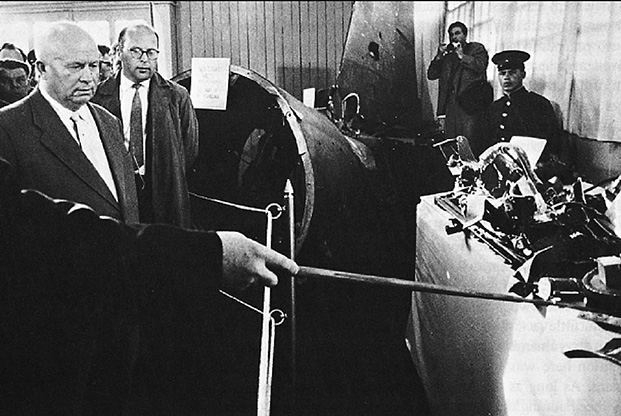
Soviet leader Nikita Khrushchev examines the wreckage of the downed U-2. The airplane remnants—and the captured pilot—were a huge propaganda coup for the Soviets. Photo: CIA
GRAND SLAM
When the Adana contingent deployed to Peshawar, they expected the full overflight mission—none too subtly named Operation Grand Slam—to occur on April 28 with Powers flying their best U-2. Bad weather forced a postponement, and the airplane was ferried back to Adana, where it was pulled from service for periodic maintenance. It was replaced for the May 1 flight with the detachment’s worst airplane, which Powers described as “never having flown exactly right.”
Thus, Powers was not too surprised when, 1,300 miles inside Russia, the autopilot conked out. An hour earlier and he would have aborted the mission, but he decided to fly the temperamental aircraft manually for the rest of the way.
He passed the Tyuratam Cosmodrome, the big Russian missile test and space launch facility, and turned north up the backbone of the Urals toward Sverdlovsk—previously known as Ekaterinburg, where the tsar and the imperial family had been executed by the Bolsheviks in 1918.
He never made it past Sverdlovsk. Four-and-a-half hours into the mission and flying at 70,500 feet, the U-2 was rocked by the detonation of a Dvina SAM close by. Powers no longer had control of the airplane, which spiraled downward, tail first. Thrown forward by centrifugal force, he managed to release the canopy to escape, but dangling by his oxygen hose, could not reach the destruct switches.
He finally broke free and descended by parachute to a small village where he was taken prisoner. He was moved to a larger village and then on to Sverdlovsk, where custody was assumed by the KGB. He had destroyed his flight map during the descent, but the ground crew had stuck a duplicate into his pack. The route from Pakistan to Norway was clearly marked.
A story persisted for years, based on a weak report from the National Security Agency, that Powers had taken the U-2 down to 34,000 feet before the missile got him. The facts were eventually sorted out by Soviet sources. The Soviets fired a total of 13 SAMs and launched a number of interceptor aircraft, one of which was a MiG-19 that was inadvertently hit by a SAM. That was stretched into the idea that Powers had flown to a lower altitude.
The capture and trial of Powers, exploited for full propaganda effect by the Russians, effectively marked the end of the U-2 overflight program. In January 1961, President John F. Kennedy continued the Eisenhower order that the flights not be resumed. The Powers mission was the 26th and final penetration of Soviet airspace.
THE AMBIGUITY LINGERS
Although Powers was technically cleared by a CIA board of inquiry and a Congressional hearing, a cloud of ambiguity hung over his head. As the official CIA history put it, John A. McCone, director of Central Intelligence 1961-1965, “remained hostile to Powers” and demanded a closer look at his actions. Both the CIA and the Air Force kept Powers at arm’s length.
In 1963, all of the U-2 pilots except Powers were awarded the CIA Intelligence Star. Two days before McCone left office, the Intelligence Star was awarded to Powers as well, with the inscription awkwardly backdated to 1963.
The Air Force notified Powers that, unlike the other U-2 returnees, his time with the CIA would not be credited toward retirement or promotion and that he would not receive the Distinguished Flying Cross he had been awarded in 1957. The DFC was presented to his family in 1986, nine years after Powers had died.
Powers enjoyed considerable support from the general public, but more than a few newspapers were critical of his failure to destroy himself. “Why, knowing that neither he nor the U-2 should fall into unfriendly hands, didn’t he blow himself up, and the plane?” asked the New York Herald Tribune. “Why didn’t Powers use the poison needle he had on hand? Or the pistol he had with him?”
Powers joined Lockheed, where he was a U-2 test pilot until 1970, then flew light aircraft and helicopters for a television station. He died in a helicopter crash in August 1977.
The CIA and the U-2 Program, the comprehensive history released by the CIA in 1998, agreed in all important respects with the story as Powers had told it in his memoir and provided a measure of long-overdue vindication from the agency.
U-2 KEEPS FLYING
The strategic intelligence value lost with the end of the U-2 overflights was replaced in the 1960s by photoreconnaissance satellites, but the U-2 remained in service with both the CIA and the Air Force.
In the Cuban Missile Crisis of 1962, the U-2 famously discovered medium- and intermediate-range Soviet ballistic missiles in Cuba. A new version of the aircraft, the U-2R, was introduced in 1967 and was 40 percent larger and more capable than the original. In 1974, the CIA stopped its participation in manned reconnaissance, leaving the U-2 operation to the Air Force.
The demise of the U-2 has been regularly predicted over the years, but the aircraft outlasted its presumed successor, the SR-71, which was retired in 1998. Subsequently, the RQ-4 Global Hawk drone was supposed to replace the U-2, but plans changed when intelligence gathered by the U-2 over Afghanistan proved to be of particularly high quality.
In 2017, the Air Force announced plans to keep the U-2S, “well into the future.” Currently, USAF operates 27 U-2s and two trainers.
—
John T. Correll was editor-in-chief of Air Force Magazine for 18 years and is a frequent contributor. His most recent article, “The Fall of France,” appeared in the December 2018 issue.